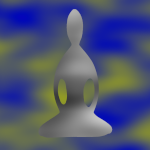Dear Friends,
Andrea Fella led a series called “Introduction to Mindfulness Meditation” in 2012. Her week 5 talk included a handout on “Mindfulness Meditation Week Five: Daily Life Practice“. One suggestion from that handout is something I’ve picked for today’s “stealth meditation”:
Choosing a Reference Point for Daily Life
A main practice for daily life that helps to provide this reference point is to pick an activity that occurs regularly throughout your day to serve as a reference point in daily life. The activity you chose can be any mundane task, preferably one that you take an action to initiate. The key is that is should be something that happens pretty frequently during the bulk of your day, say at least three or four times an hour. This task essentially becomes your reference point.
There are many activities you could choose as a reference point. For example, you could choose the action of standing up …
I attend the Sunday morning meditation and study group (as do a few others in this email group). We listen to a pre-determined recording during the week, and then on the Sunday morning, after a 30 minute meditation, we have time to discuss the recording and our personal experience as it relates to the teaching. We’re currently working our way through a series on the Four Noble Truths & Brahmaviharas, which was from a week-long retreat last year.
The talk we listened to last Sunday was a Guided instruction on Breath – a 39 minute session, with a guided meditation on the breath to start, and then a discussion of moving into a walking practice. Starting at about 28 minutes into the recording, the teacher, JoAnna Harper, suggested the participants pay close attention to transitions “to what is happening, internally and externally, while we are changing our posture.” JoAnna suggests we “pay attention to that first movement; pay attention even before that first movement, noticing the intention … to move the body from sitting to standing.”
She asks, “if you’re going to stand up right now, what are you going to do first?”
And don’t worry, Andrea Fella includes this reminder in her handout:
When you first start working with a reference point task, standing up for example, probably you will stand up many times before you remember! You might remember only when you go to bed at night. The fact that you haven’t remembered all day long is not a problem. That moment of remembering is equivalent to the moment in sitting meditation when you remember that your mind has wandered off of the breathing. In that moment we know: “Here I am now, and I’ve forgotten to do what I set my mind to do.” That moment is not an indication that you can’t do this practice, in fact it is just the opposite.
…
Over the course of a few days, you might notice more frequently during the day that you haven’t been noticing your task. If you notice four of five times during the day, that is four or five moments of mindfulness you probably would not have had. Increasing the number of moments of mindfulness in the day is mostly the point of this practice. There is no need to judge yourself for not remembering the actual task. The task is a reference point to help you remember, so you can begin to know how mindful you actually are during the day.
…
The tasks I’m suggesting as a reference point are quite brief, often lasting only a few seconds. There is no need to try to hold on to the mindfulness past those few seconds. For instance, in the moment of standing, just know that you are standing.
…
See if you can hold this practice with a really light touch. It is not meant to feel burdensome on your day. With this emphasis on picking a mindfulness project, keep in mind that the task is not so much about the project itself, it is more about waking up, and remembering to be mindful.
With best wishes,
Andrea G
